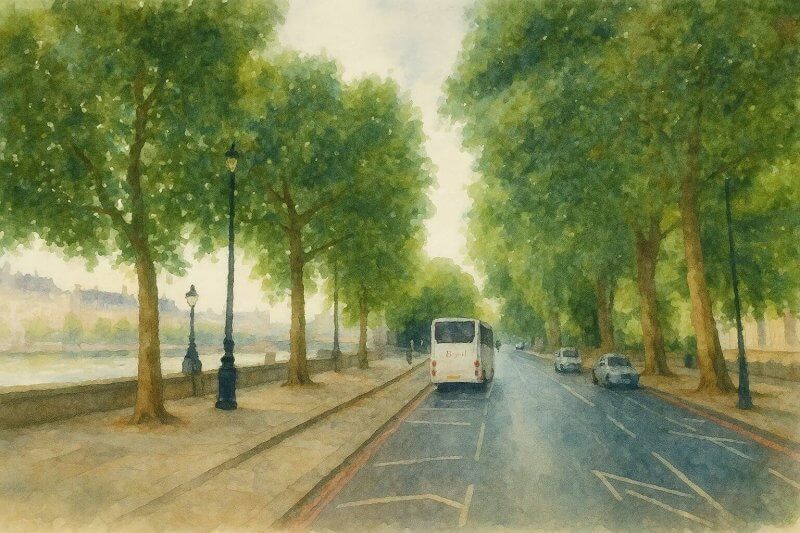
Victoria Embankment, London
Historical Context and Construction
The mid-19th century saw London grappling with severe sanitation issues, culminating in the infamous "Great Stink" of 1858. The River Thames had become heavily polluted, posing serious health risks to the city's inhabitants. In response, Sir Joseph Bazalgette devised an ambitious plan to overhaul the city's sewer system. A key component of this plan was the construction of the Victoria Embankment, which not only housed a major low-level interceptor sewer but also incorporated the Metropolitan District Railway (now part of the Circle and District Lines) beneath its surface. This innovative design reclaimed 37 acres of land from the Thames, providing space for new underground railways and a sewer system, while also creating a new thoroughfare and public space above.Map of Victoria Embankment, London
Connecting Roads and Features
Victoria Embankment, designated as part of the A3211 road, begins at Westminster Bridge, adjacent to the Palace of Westminster. It runs parallel to the Thames, passing notable landmarks such as Cleopatra's Needle and the Savoy Hotel, before concluding at Blackfriars Bridge. Along its route, several streets and thoroughfares intersect or branch off, including Horse Guards Avenue, Northumberland Avenue, Savoy Place, Savoy Street, Temple Place, Middle Temple Lane and Queen Victoria Street. The embankment also features the Victoria Embankment Gardens, a series of public gardens that provide a green respite amidst the urban landscape.Naming and Dedication
The embankment was named in honor of Queen Victoria, reflecting the era's penchant for commemorating the reigning monarch in public works. The official opening ceremony took place on July 13, 1870, presided over by the Prince of Wales and Princess Louise, marking a significant milestone in London's urban development.Nearest Underground Stations
For those utilizing public transportation, the London Underground stations most conveniently located near Victoria Embankment are Embankment and Temple. Embankment station provides access to the Bakerloo, Northern, Circle, and District lines, while Temple station serves the Circle and District lines. These stations facilitate easy exploration of the embankment and its surrounding attractions.Notable Landmarks and Features
- Cleopatra's Needle: Erected in 1878, this ancient Egyptian obelisk dates back to around 1450 BC and was originally commissioned by Pharaoh Thutmose III. Gifted to the United Kingdom by the ruler of Egypt and Sudan, Muhammad Ali, in 1819, it was transported to London and now stands prominently on the embankment, flanked by two faux-Egyptian sphinxes designed by architect George John Vulliamy.
- Victoria Embankment Gardens: Designed by landscape gardener Alexander McKenzie and opened between 1870 and 1875, these gardens were created on reclaimed land and offer a tranquil retreat featuring statues, memorials, and beautifully landscaped areas. Notable sculptures include those of John Stuart Mill and a memorial to the poet Robert Burns.
- York Watergate: Located within the Victoria Embankment Gardens, this historical structure was built in 1626 as a river entrance to the Duke of Buckingham's York House. Due to the embankment's construction and subsequent changes to the river's edge, the watergate now stands approximately 100 meters from the Thames, serving as a poignant reminder of the river's historical shoreline.

Painting of Victoria Embankment (View full-size image here)
Interesting Facts about the Victoria Embankment
- Pioneering Street Lighting: In December 1878, Victoria Embankment became the first street in Britain to be permanently lit by electricity. The initial lighting system featured 20 Yablochkov candles powered by a Gramme DC generator, marking a significant advancement in urban infrastructure and setting a precedent for future developments in street illumination.
- Architectural Influence: The concept of embanking the Thames to create a roadway was first proposed by Sir Christopher Wren in the 1660s. However, it wasn't until the 19th century that Bazalgette's vision brought this idea to fruition, showcasing the evolution of urban planning over the centuries.
- Monopoly Connection: Northumberland Avenue, which intersects with Victoria Embankment, is famously featured as a property on the British version of the Monopoly board game, highlighting its prominence in London's geography.